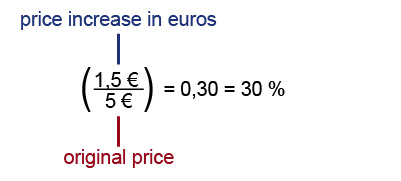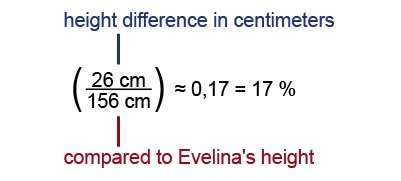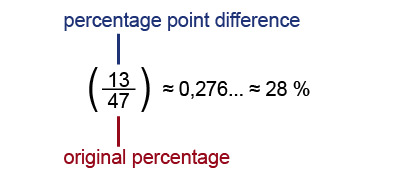Changes and comparisons in percentages
Percentage changes
When calculating the percentage by which something has changed (i.e. increased or decreased):- the magnitude of the change is calculated first.
- the percentage change from the original value is then calculated.
Example 1
The price of a film ticket was increased from [[$ 5 $]] € to [[$ 6,5 $]] €. By what percentage did the price increase?
The price increase in €:
[[$ 6,5 \: \text {€} \: - 5 \: \text {€} = 1,5 \: \text {€} $]]
The price increase as a percentage:

Answer: The price of a movie ticket increased by [[$ 30 \: \% $]].
Comparison percentage
When calculating what percentage of a number is greater or smaller than another number:- the difference between the two numbers is calculated first.
- the difference of the numbers is compared to the number that follows the word "than".
Example 2
Evelina is [[$ 156 $]] cm tall, whereas Tony is [[$ 182 $]] cm tall.
a) By what percentage is Tony taller than Evelina?
The height difference in centimeters:
[[$ 182 \: \text {cm} \: – 156 \: \text {cm} = 26 \: \text {cm} $]].
The percentage difference:

b) By what percentage is Evelina shorter than Tony?

Answer: a) Tony is [[$ 17 \: \% $]] taller than Evelina and b) Evelina is[[$ 14 \: \% $]] shorter than Tony.
NB! Comparison percentages are calculated in the same way as percentage changes. The difference between the two concepts is that percentage changes are always compared to a specific original value, whereas comparison percentages can be compared to all of the values that are examined.
Percentage point
The percentage point is different from the percentage. The change in percentage points is obtained by calculating the difference between two percentages.Example 3
Popular support for nuclear power fell from [[$ 47 $]] percent to [[$ 34 $]] percent.
a) By how many percentage points did the support decrease?
[[$ 47 \: - 34 = 13 $]]
b) By what percentage did the support decrease?

Answer: The support decresed by a) by [[$ 13 $]] percentage points and b) by [[$ 28 \: \% $]].